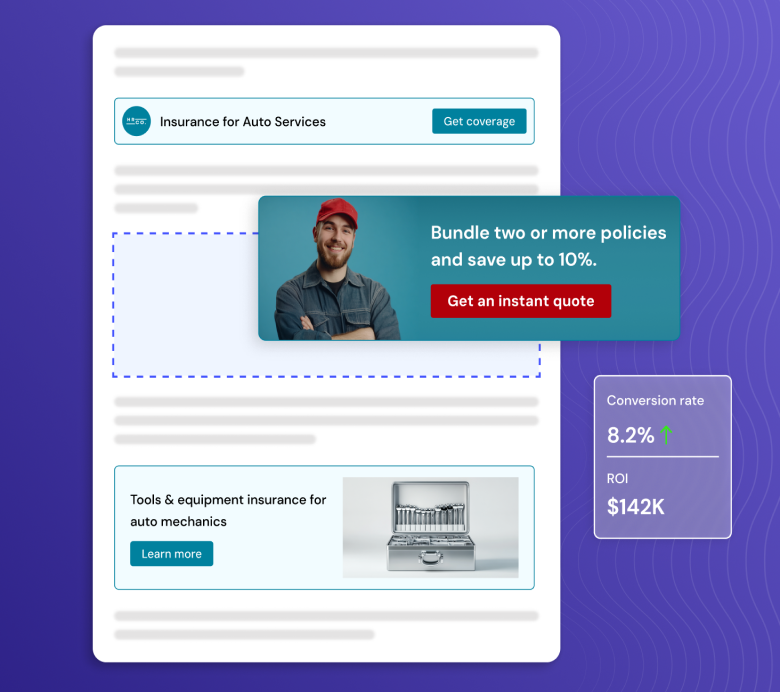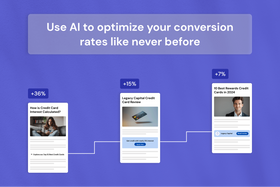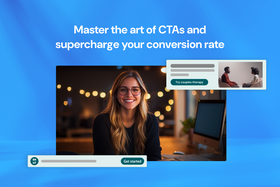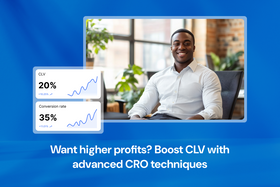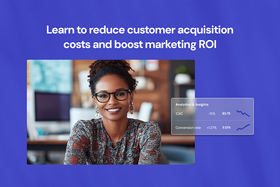What is B2B lead generation? 8 strategies to attract more leads
Looking to grow your business? Understand B2B lead generation from the ground up and discover actionable strategies to generate high-quality B2B leads that convert.
Published May 15, 2025
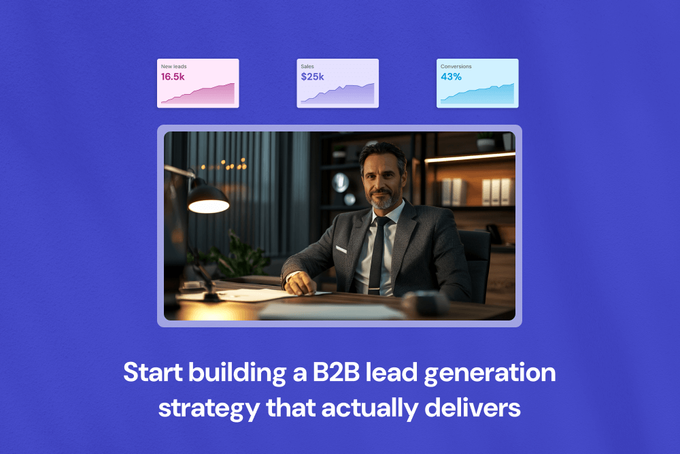
B2B lead generation is one of the most critical and most challenging parts of the marketing funnel. Finding high-quality leads at scale remains a top struggle for many teams, with 42% of businesses reporting issues with low-quality or irrelevant leads. Even companies with strong nurturing and sales processes often find their efforts limited by the quality of leads entering their pipeline.
A strong B2B lead generation strategy is the foundation for sustainable success. So, let's explore what B2B lead generation really is and how to optimize your lead generation efforts to increase the volume and quality of your leads.
Key takeaways
- B2B lead generation is the foundation of a sustainable sales pipeline.
- Multi-channel strategies capture prospects across various touchpoints.
- Proper lead qualification prevents wasted resources on poor-fit leads.
- Personalized nurturing dramatically improves conversion rates.
What is B2B lead generation?
B2B lead generation is the process of identifying ideal potential buyers for your product or service and enticing them to purchase. It's the critical first step where sales and marketing teams find, approach, nurture, and convert prospects into customers.
Effective B2B lead generation often involves multiple marketing channels to create a powerful combination of inbound and outbound strategies.
Think of it like this: If you sell office furniture to businesses, you don't just wait for companies to find you. You proactively identify companies expanding or renovating offices, reach out through email, calls, or LinkedIn, and build relationships until they're ready to buy.
This systematic approach to finding and qualifying potential business customers ensures your sales team focuses on prospects most likely to convert, rather than chasing dead ends.
» Find out how SEO lead generation can help you attract and convert qualified B2B leads.
The importance of B2B lead generation
Why devote resources to lead generation when you could focus solely on your product or service? The answer is simple: without a consistent flow of new prospects, even the best offerings will struggle to find their market.
Here are just a few benefits of B2B lead generation:
- Increased sales opportunities: Lead generation creates a pipeline of potential clients interested in your solutions. By targeting the right audience and capturing their attention early, you create more opportunities for them to convert down the line.
- Improved ROI: Focused B2B lead generation delivers better returns than broad marketing efforts that don't target specific prospects. By zeroing in on companies that match your ideal customer profile, you ensure every dollar spent brings you closer to qualified buyers, improving your ROI.
- Enhanced customer understanding: Through the lead generation process, you gain valuable insights into your market's pain points, preferences, and buying behaviors. These insights help you refine your offerings and position yourself as a solution.
Types of B2B leads
Not all leads are created equal. Understanding the different types helps you categorize, prioritize, and nurture leads effectively:
1. Marketing qualified leads (MQLs)
Marketing qualified leads have shown initial interest in your company by engaging with your marketing efforts. These prospects have taken actions like downloading whitepapers, subscribing to newsletters, or attending webinars.
MQLs have demonstrated they're interested in the topics or problems your business addresses, but they're not necessarily ready to make a purchase. They're typically in the awareness or early consideration stage of your conversion funnel.
Your marketing team handles these leads, nurturing them with educational content until they show stronger buying signals.
» Create content that converts to lead MQLs further down the funnel.
2. Sales qualified leads (SQLs)
Sales qualified leads have moved beyond general interest and shown clear purchase intent. These prospects have taken high-value actions like requesting a demo, asking for pricing information, or booking a consultation.
SQLs are usually in the late consideration or decision stage of the buying process. They've been vetted by both marketing and sales teams and deemed ready for direct sales outreach.
These leads typically have the budget, authority, need, and timeframe (BANT) aligned for a potential purchase, making them much more likely to convert than MQLs.
» Learn how to nurture leads through different stages of the user journey.
3. Product qualified leads (PQLs)
Product qualified leads have experienced your product firsthand and shown engagement that indicates they're a good fit for becoming a paying customer.
Common in B2B SaaS, PQLs typically come from free trial users or freemium account holders who have reached usage thresholds or explored premium features.
» Are you in the B2B fintech space? Explore these B2B fintech marketing strategies.
What makes PQLs especially valuable is their hands-on experience with your solution. They don't just understand your product conceptually—they've actually used it to solve their problems. This experience-based qualification often leads to faster sales cycles and higher conversion rates.
4. Information Qualified Leads (IQLs)
Information qualified leads are very early-stage prospects actively seeking information about solutions in your category. These leads are researching their problems and potential solutions, but aren't yet evaluating specific vendors.
IQLs might download educational resources or read blog content, but the nature of their engagement indicates they're still defining their needs. These leads require long-term nurturing with helpful, non-promotional content that helps them better understand their challenges and potential solutions.
» Attract IQLs with these top-of-the-funnel marketing tips.
5. Service qualified leads (SQLs)
Service qualified leads are existing customers who have expressed interest in additional products or services you offer. These opportunities arise when current customers inquire about upgrading their plan, adding more users, or expanding into other solution areas.
Service qualified leads are among your most valuable prospects because they already understand your value proposition and have an established relationship with your company.
The cost of selling to existing customers is typically 5-25 times lower than acquiring new ones, making these leads especially profitable.
What is the B2B lead generation process?
The B2B lead generation process follows a structured approach that guides potential customers from awareness to purchase. To optimize for conversions, each stage of this process must be carefully designed with your conversion goals in mind.
1. Define your target audience
Start by clearly identifying who your ideal customers are. Create detailed buyer personas based on industry and company size, job titles and decision-making authority, key pain points, and purchasing timelines.
This foundation ensures all subsequent lead generation activities target the right prospects for maximum conversion potential.
2. Choose your lead generation channels
Select the most appropriate channels to reach your target audience. Effective B2B lead generation typically uses a mix of inbound channels like content marketing, SEO, and webinars, alongside outbound channels such as targeted email campaigns, LinkedIn outreach, paid search, and advertising.
Optimize each channel for conversions with clear paths to lead capture.
READ MORE: What is a conversion path? A clear and simple explanation
3. Create lead capture mechanisms
Collect prospect information through methods such as website forms, gated content downloads, webinar registrations, and free trials or consultations.
A well-designed customer journey map helps identify optimal placement for these touchpoints, ensuring they appear when prospects are most receptive. Each capture mechanism should be conversion-optimized with compelling CTAs, minimal form fields, and clear value propositions.
4. Qualify and nurture leads
Not all leads deserve equal attention. Implement lead scoring to prioritize your efforts based on demographic fit, engagement level, and purchase intent signals. Build conversion-focused nurture sequences that guide prospects closer to purchase decisions.
» Nurture leads with these middle-of-the-funnel marketing techniques.
5. Hand off to sales
When leads reach qualification thresholds, transfer them to your sales team with comprehensive lead information, clear handoff criteria, and good communication between marketing and sales.
This final stage of the lead generation process should be optimized to ensure a smooth transition that maximizes conversion opportunities.
» Learn about the sales funnel and how to optimize it.
8 B2B lead generation strategies
Now let's explore some of the most effective B2B lead generation strategies to convert visitors.
1. Content marketing and SEO
Content remains king in B2B lead generation. Create valuable, educational, authentic content addressing your target audience's pain points to attract potential customers through organic search and position your company as an industry authority.
Content marketing generates three times more leads than traditional outbound marketing while costing 62% less, making it one of the most cost-effective lead generation strategies.
How to implement this strategy: Create content for different funnel stages, focus on educational resources, optimize for SEO, and include clear, persuasive CTAs.
READ MORE: 10 types of content marketing and how to use them (+ examples)
2. LinkedIn and social selling
LinkedIn has become the dominant platform for B2B lead generation, with research showing that companies not using LinkedIn in their marketing mix risk losing out to competitors in 2025.
How to implement this strategy: Optimize profiles, share thought leadership consistently, engage in industry conversations, and use LinkedIn Sales Navigator for targeted prospecting with personalized outreach.
3. Email marketing automation
Strategic email marketing remains one of the highest-ROI lead generation channels, with properly segmented campaigns yielding significantly better results than generic email blasts.
How to implement this strategy: Segment your email list, create targeted nurture sequences, use behavioral triggers, test and optimize campaigns, and provide genuine value before asking for the sale.
4. Contextual CTAs and conversion optimization
Many companies focus heavily on driving traffic but fail to convert blog traffic into leads effectively. Implementing strategic conversion paths throughout your content can dramatically improve lead generation results.
How to implement this strategy: Add contextual CTA that match content topics, create dedicated landing pages, implement A/B testing, and ensure mobile optimization for all conversion points.
» Get inspired by our favorite CTA examples.
5. Webinars and virtual events
Webinars combine educational content with interactive engagement, allowing you to demonstrate expertise while capturing valuable lead information.
How to implement this strategy: Choose topics addressing specific pain points, include interactive elements, follow up with targeted content, and repurpose recordings as on-demand lead generation assets.
6. Account-based marketing (ABM)
Rather than casting a wide net, ABM focuses your resources on specific high-value accounts most likely to generate significant revenue. This targeted approach often yields higher-quality leads and better ROI.
How to implement this strategy: Identify target accounts, research key stakeholders, create personalized content, and coordinate marketing and sales efforts for consistent messaging.
7. Intent data and predictive analytics
Modern B2B lead generation increasingly relies on intent data—signals that indicate a company is actively researching solutions like yours, helping you focus on prospects with the highest conversion potential.
This allows you to convert users based on intent, targeting them precisely when they're most receptive to your messaging.
How to implement this strategy: Invest in intent data platforms like Entail CRO, create trigger-based campaigns, and train sales teams to prioritize outreach based on intent scores.
» Give your lead generation strategy an edge with the best CRO tools.
8. Referral programs
Referred leads close faster and stay longer, with B2B companies reporting significantly higher conversion rates for referred leads. A structured referral program can systematically leverage your existing customer relationships.
How to implement this strategy: Create incentives for referrals, make the process simple, and train customer success teams to identify referral opportunities.
Measuring the effectiveness of B2B lead generation
To gauge the effectiveness of your B2B lead generation efforts, track these key conversion metrics:
1. Conversion rates
Conversion rates tell you what percentage of leads are progressing through each stage of your funnel. Monitor visitor-to-lead conversion rate, lead-to-MQL conversion rate, MQL-to-SQL conversion rate, and opportunity-to-customer conversion rate.
2. Return on investment (ROI)
ROI measures the profitability of your lead generation investments by comparing revenue generated from leads against the cost of lead generation. This metric helps you determine which channels and campaigns deliver the best returns.
3. Lead quality
Not all leads are equal. Monitor the quality of your leads by tracking fit with the ideal customer profile, engagement level, conversion probability, average deal size, and sales cycle length. High-quality leads convert faster and generate more revenue than low-quality leads.
4. Cost per lead (CPL)
CPL helps you understand how efficiently you're generating leads by dividing the total cost of lead generation by the number of leads generated. Track CPL by channel to identify your most cost-effective lead sources.
Getting started with B2B lead generation
To increase your B2B lead generation, start by understanding your ideal customers, creating content that addresses their pain points, and implementing multiple channels to reach them.
You can use the strategies outlined in this article can help you significantly boost your lead volume and quality. And with some consistent effort and strategic optimization, your B2B lead generation process can become a reliable engine driving users toward conversion.
» Get high-quality B2B leads with our SEO lead generation tool.
